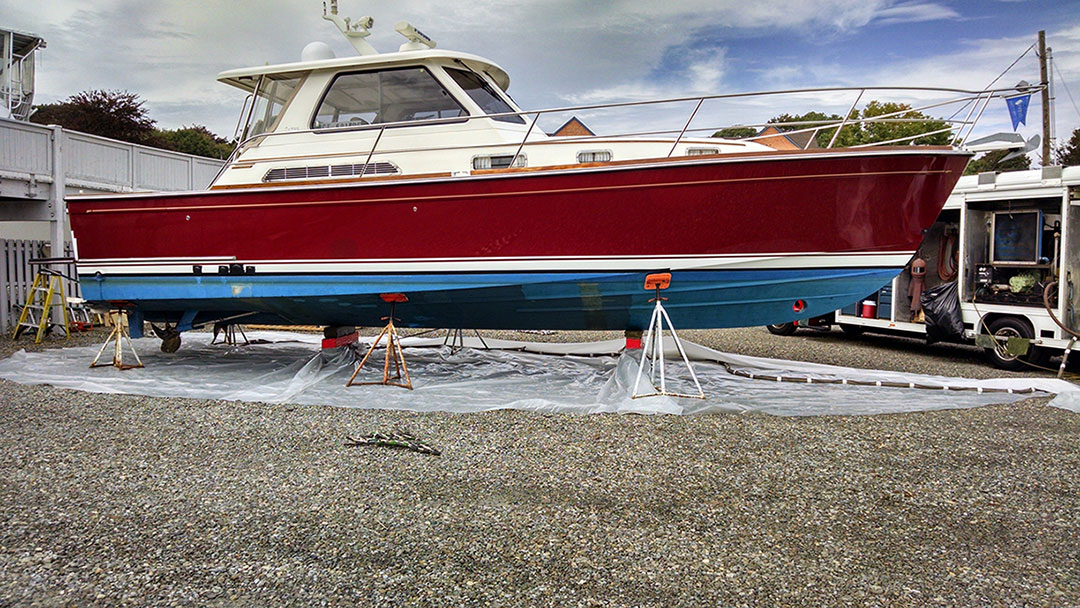We’ve never, ever heard someone voice enthusiasm for scraping the bottom of a boat; it is one of those chores rightfully called a chore. However, for many boat owners or boat yard managers in Connecticut, New York and Southern New England, Billings Media Blasting has become their first choice when it’s time to strip the bottom of a boat.
We have become experts in boat bottom blasting. Our efficient, cost effective and environmentally sound process allows us to quickly strip bottom paint without damaging the gel and/or barrier coat and, most importantly, without leaving a mess. Our work is done with the marina environment in mind; we work quickly, efficiently and make certain none of the stripping by products (media, stripped paint, plastic, etc.) escape to the yard or nearby water.
We started removing bottom paint using the familiar baking soda blasting process, but our preferred method now is crushed walnut shell blasting. We’ve found that walnut shell can be even gentler to the gel coat and barrier coat, is less dusty, non-corrosive and tends to open blisters while removing bottom paint.
Please note: media blasting is just the first step in preparing a boat bottom for paint. Our process removes bottom paint but does not leave the bottom ready for paint re-application. Please carefully read surface preparation procedures listed on the products being used in order to achieve proper results.
Our Process
We begin by creating a tent to collect blasting material and the paint we blast from bottom of the boat. The first step is to create a floor underneath the boat; for this we use 4 mil plastic and our proprietary adhesive.
Next, we create the sides of the blasting tent using 4 mil plastic. We tape the plastic above the boot stripe with shrink patch tape, which protects most gel coats and most painted boats. Once taped to the boat, the plastic sides are joined to the plastic floor, creating an airtight space to contain blasting media and removed bottom paint during the blasting procedure. Our tenting system has proven successful even when we work indoors amidst dozens of surrounding boats as they never show any evidence of any residual dust.
Once blasting begins, the tent inflates like a balloon due to the air entering the tent through the blasting hose. We use suction to collect dust while blasting to control tent inflation; this prevents over inflation which could cause leaks or a blowout causing dust to exit the tent into the yard. Please note: all thru hulls must be closed prior to our process due to the pressure build-up in the tent.
Upon completing the blasting process, the dust is allowed to settle. We then take down the tent and collect the used materials. As depicted in this photo, there is no mess left; we take great pride in being as clean as possible.
Once stripping is complete, the boat owner or yard worker proceeds with final preparation stages in accordance with the instructions for the product they have selected to paint the bottom of the boat. On this boat, the barrier coat and some slight stains remained, but results will vary.
Benefits of Boat Bottom Blasting
Why should you get your bottom blasted? The first reason, obviously, is that stripping a boat bottom is dirty and difficult work. Our process addresses both those issues. Second, layer upon layer of boat bottom paint over a vessel’s lifespan leads to significant buildup, adding unnecessary weight and, in some cases, drag from flaking or sloughing paint. Third, paint applied to a flaking or uneven surface doesn’t stick to the boat. Boat bottom blasting provides a fresh start, assuring the products used are applied correctly. Another practice we’ve seen is to have the bottom blasted after a used boat purchase; underlying problems covered up with bottom paint can be uncovered, addressed and proper coatings and procedures can be followed when re-applying bottom paint. Whatever reason for bottom paint removal, Billings Media Blasting will ensure it is removed gently and efficiently.
Dangers of conventional methods
The conventional process of stripping paint from boat bottoms includes many manual and potentially harmful steps. First, heavy marine growth must be scrapped with flat blades; excessive or inexact scraping can gouge into the gel coat. Then, after waiting until the surface is dry, hull sanding commences. This phase carries a high risk for damaging the hull; it’s a difficult, manual process and is virtually impossible to keep from sanding into gel coat (once the gel coat is damaged, water can get between it and the fiberglass causing blisters, fractures, and delamination). The original gel coat is smooth in texture and serves as a protective barrier of the underlying fiberglass.
If you would like to learn more about our boat bottom blasting capabilities or to arrange a free estimate, drop us an email. To download and review our boat bottom blasting contract, click here.


